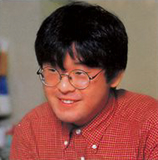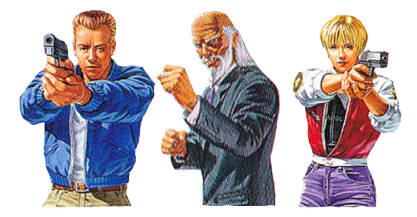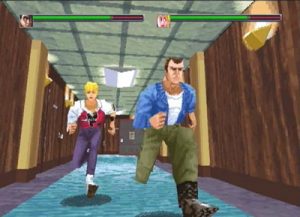 The following interview was originally published in the August 1996 issue of Sega Saturn Magazine. It was translated by the author as research material for the Die Hard Arcade section of the book The Sega Arcade Revolution: A History in 62 Games. AM1 programmer Susumi Hirai was has not been confirmed to have been involved with Dynamite Deka’s development (he’s listed in the “special thanks” section), so it is unclear as to why he was chosen for the interview. Even so, the short Q&A holds some interesting tidbits of information regarding what would become Sega’s most successful American-developed arcade game, and a Saturn classic.
The following interview was originally published in the August 1996 issue of Sega Saturn Magazine. It was translated by the author as research material for the Die Hard Arcade section of the book The Sega Arcade Revolution: A History in 62 Games. AM1 programmer Susumi Hirai was has not been confirmed to have been involved with Dynamite Deka’s development (he’s listed in the “special thanks” section), so it is unclear as to why he was chosen for the interview. Even so, the short Q&A holds some interesting tidbits of information regarding what would become Sega’s most successful American-developed arcade game, and a Saturn classic.
Sega Saturn Magazine: Please introduce us to this new project, the first game by AM1 in a while.
Susumi Hirai: In the early stage of development we wanted to make a game on ST-V hardware with visuals on par with a Model 2 game. A side-scrolling beat ‘em up was not a novel concept at that point, it was an old genre. There was Golden Axe for example. However, these games can be enjoyed in various ways by both beginners and experts, and we felt it would be a shame to disregard that. We wanted to show the genre in a new light, so stylistically we tried to make it look as much as an action movie as possible and put a lot of focus on showing the story developing. Since we were working with polygons we made heavy use of camera work; the goal was basically to evolve the side-scrolling beat ‘em up.
Sega Saturn Magazine: Is the game available outside of Japan?
Susumi Hirai: Yes. Honestly, when it comes to the development of this game, the American team was the main team, while we here mainly just supported them. So the designers, programmers, artists etc. were all Americans ( laughs). But director Makoto Uchida was a member of AM1, just to make sure.
Sega Saturn Magazine: I heard that the Western version has a different title.

Susumi Hirai: That’s right. It’s called Die Hard Arcade.
Sega Saturn Magazine: Why is the Japanese version called Dynamite Deka?
Susumi Hirai: Well, there are a lot of confidential matters involved, so I can’t really give you an answer. But as for the origin of the name, it’s said that when the person in charge of coming up with a name saw a screen of the game for the first time, they went “This is dynamite!” (laughs).
Sega Saturn Magazine: Was the idea of implementing cinematic elements around from the beginning?
Susumi Hirai: Yes, we thought about it very early. It gave us more freedom than using CG, so we thought about using it to present the story and action in a cinematic way. Compared to future action games there are a lot of big and small techniques in the game. The techniques were another thing that could be made visually impressive through camera work. As for the inputs, we made it so beginners can perform the techniques more or less. But if you get used to it, you can of course do them intentionally. To put it a different way, you can direct your own scenes. I think that was another big reason for us.
Sega Saturn Magazine: The goal of the game is to rescue the president’s daughter. But could you tell us about enjoyable parts during the gameplay?
Susumi Hirai: You can arrest people and use special moves, or try to pick up items in the area. Depending on what you pick up you can create different situations. You can also destroy things in the background that you can’t use as items.
 Sega Saturn Magazine: The game was developed on ST-V. Can we expect a Saturn port?
Sega Saturn Magazine: The game was developed on ST-V. Can we expect a Saturn port?
Susumi Hirai: Well…maybe yes, maybe no (laughs). If it doesn’t make money in the arcade, I wouldn’t hold my breath for a port (laughs). Ah, but if your readers give us enough encouragement we’ll start working on a port right away.
Sega Saturn Magazine: Finally, do you have a message for our readers?
Susumi Hirai: Since Dynamite Deka evokes Die Hard, both the American team and we hope that you can slip into the role of the protagonist and have a blast punching your way through the game.
For the complete story of Die Hard Arcade’s development, be sure to read The Sega Arcade Revolution: A History in 62 Games. The book chronicles Sega’s arcade legacy from 1966-2003 and is available in paperback and digital formats now from Amazon.

Recent Comments